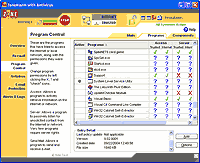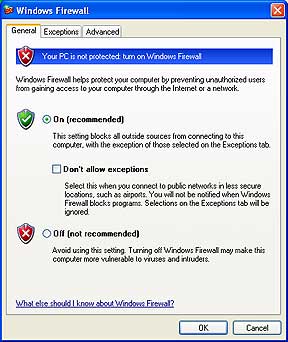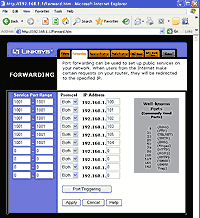
Online Playing Help
SpiteNET Internet or LAN (Home Network) games
Connection Problems - things that can prevent your game from connecting
Home Network Router and Port Settings
Incorrect IP Address Displayed
Can't HOST - your are able to play online, but you can only connect if you act as the Remote player
Games don't connect, attempts always time out. Got a FIREWALL?
Connection times out while waiting to
connect:
This can happen for several reasons:
Firewalls are designed to protect your computer
from unwanted intruders. But the firewall doesn't know which programs you  want
to allow to pass through unless you give the software program permission.
want
to allow to pass through unless you give the software program permission.
Most often, when your game times out while waiting for an opponent, either you or your opponent has a firewall that is preventing the games from connecting.
With SpiteNET games, your game acts as a Server (if you are the Host) or needs to accept incoming data (if you are the Remote). These are 2 separate settings that you need to give the game permission for in your firewall software.
Click
the picture to view a larger image of the Zone Alarm fire wall setup screen.
 Windows
XP Firewall - If you know for a fact that you have
another firewall and the WinXP firewall is also on, turn off the WinXP firewall!
Don't ever use 2 firewalls!
Windows
XP Firewall - If you know for a fact that you have
another firewall and the WinXP firewall is also on, turn off the WinXP firewall!
Don't ever use 2 firewalls!
If you are using the WinXP firewall (set to ON), first make sure that the "Don't allow exceptions" check box is UNCHECKED.
Next, click the Exceptions tab. Look for the game in the Programs and Services list. It should say: "Play SpiteNET Spite and Malice v9" and next to it, the box should be CHECKED. If it is not there, click the "Add Program" button and scroll down the list until you find "Play SpiteNET Spite and Malice v9" or "SpiteNET Spite and Malice v.9." If you can't find it on the list, use the browse button to go to C: Program Files, SpiteNET9 and select SpiteNET9.exe. Click OK and it will show on your exceptions list.
Select the game from that list and click the "Edit button." Click the "Change scope" button and check that "Any computer" is selected. Click OK, then OK again and you are back at the Exceptions window.
Click the "Add Port" button. In the Name box, type: SpitePort
In the Port number box, type: 1001
TCP should be the protocol selected.
Click OK to save and exit that window.
Click OK again to exit the WinXP firewall window. It may not be needed, but it wouldn't hurt to reboot your computer at this point.
Norton System Works - Includes their lite version of a firewall called "Norton Internet Worm" protection. Open up Norton System Works and navigate to the Internet Worm section. In the Program Control section, give the game all permissions.
Other Firewalls - There are too many firewall software programs to list them here, but generally each one has a section called "Program Control" where you give permission for programs to pass through the firewall. Give the game all permissions. The game must have server rights to act as Host.
Cable/DSL Router - Networked computer
If you have a home Network with a Cable/DSL Router and you act as the Host, your game may not display your Internet IP Address, only your local network address (192.168.1.xxx). The security in the Router may prevent your actual IP Address from displaying in the game. Consult your Router manual for how to obtain your IP Address so that you can give it to your opponent. (Or easier still, just let your opponent be the Host.)
If you still have trouble trying to figure out your IP Address, here's a link that will display it for you in your browser:
http://www.spitenet.com/ipaddress.html
Click on the picture to enlarge and view the Linksys
screen. For most routers, type 192.168.1.1 into your
browser to display your router settings. You'll need your router password. For help with with routers including DSL and cable modem
routers, visit this site: There you will find models of most routers available today
and step by step instructions for how to set Port permissions. After locating
your router/modem model, click on it and you will see a screen with an
alphabetical listing of programs. Above the list you will see a link for Default
Guide. Use that one. The Port Range for SpiteNET card games is 1001 ~ 1001.
Ping an IP Address You can ping the IP Address you’re trying to connect to. If the result is “timed-out” then the IP Address you are trying to connect to is blocking the connection, so your games can’t connect.
From Windows’ START button, type CMD in the run or start search box. A command window will open. Type in: ping [and the ip address] (That’s just an example IP Address, use the one your opponent gives you)
It then displays a series of Replies if it’s reaching the address. Type in: exit
While playing a SpiteNET game you may receive
a prolonged WAIT message if your opponent is opening certain game menu windows
during your turn. The game can't continue until they return to the game
board.
In Spite and Malice, the Customize Comments window is independent and will not interfere with
anything, so you can edit your comments files without holding up the game.
With V.6.1.+ you can also freely open the Internet Scores window without
interference.
If there is a general lag in transmission
time between each move, that is controlled by Internet traffic, not the
game. So depending upon what time of the day/night you are playing or the
number of users connected to your local Internet service provider, it will
respond faster or slower.
If you have a slow modem connection (28800) and/or an old
slower processor machine, this will naturally slow down the speed at which card
moves are transmitted between games. The same holds true even if you have a fast
connection but the opponent you are playing against doesn't. (You can transmit
quickly but the delay will be on your opponent's side.)
To see your "actual" IP Address, here's a link that will
display it for you in your browser:
http://www.spitenet.com/ipaddress.html
The number that comes up there is the number to give your
opponent. This link can be reached from inside the game as well. From the
game's Help Menu, choose Visit the Internet Site and then IP Address Check.
Compare that IP Address to the one(s) you get from the game
when you Host. If it is different from the one you get from the game, don't use
the one from the game.
If
you have a home Network with a Cable/DSL Router and you act as the
Host, your game may not display your Internet IP Address, only your local
network address (192.168.xxx.xxx). The security in the Router may prevent your
actual IP Address from displaying in the game. The Router
section of this Help page may help you. If you have
an ISP and AOL, the game may display the wrong IP Address.
Different firewalls may also hide your "actual" IP Address
from the game.
Don't forget that you IP Address may change every time you
reboot your computer or redial to the Internet.
If you are able to act as the Remote player, but not able
to Host, there are several settings on your computer that you have to check.
1) Use your correct IP Address - The game
provides you with one or more IP Addresses that you must give to your
opponent in order for them to connect to you.
If you get an IP Address that begins with
192.168.xxx.xxx - do not use it. That is your home network IP Address, and
is not for use in connecting to someone else on the Internet.
Some routers and firewalls hide your "real" IP Address.
To be sure that the IP Address you are giving your opponent is correct,
verify the address by going to the game's Help Menu, Visit the Internet
Site, IP Address Check option. You can also go directly to that web page
through this link:
http://www.spitenet.com/online/ipaddress.html
Click the "Display IP Address" on that page and you will
be shown your actual IP Address. This is the IP Address that you must give
your opponent if it is different from the one that the game is showing you.
Remember that IP Addresses can change! The IP Address
you used yesterday may not be the one you are assigned today.
2) Networked computer/DSL
modems - Router Port Permission - If one of the IP Addresses the game gives you starts
with 192.168.xxx.xxx, then you ARE on a networked computer. The game must
have permission to use the Port 1001 in order for someone to connect to your
game. Read this section Home Network Router and Port
Settings to configure your network to allow Port 1001.
3) Firewall permission
- The game needs permission to pass through your firewall in order for
someone to connect to you. You must know what firewall software you
are using. Zone Alarm is the most popular, but there are many companies that
sell firewalls. If you haven't downloaded or purchased one and you are using
Windows XP, then you probably have the WinXP firewall, even if you are not
aware of it. To see if you
are using the Windows XP firewall, open up your Windows Control Panel, and
then open the Windows Firewall icon. Is the Windows Firewall set to ON or
OFF?
Please read the Firewall
section of the Help page for settings instructions.
3) Port permission -
Port permission is discussed in both the Windows XP
firewall section and the Network Router section.
If you connect your game to someone else's more than 5
times a day, reboot your computer! Some versions of Windows have a problem when
the connection socket is reused many times during a Windows session (a session
being the time between shutting down or rebooting your computer). Some people
have gotten into the habit of leaving their computers on for days, never
shutting it off or rebooting. Rebooting your computer is like freshening up, and
is something you should do at least once a day. If you play against people with different versions of the
game, before connecting, close (exit) your game completely. Although every
effort has been made to make all versions of the game compatible, playing
against people with older versions can throw some game settings off. Restarting
your game before connecting to a different player with a different version will
help. Closing your game means to exit the game software - not just
disconnecting the online game.
 Port permission: Some Routers also need to have the
port permission set for
the game to connect to others. Again, consult your router manual for information
on how to do this. With Linksys Routers, you would go to the router setup (type
192.168.1.1 into your browser) and then click the display’s
Advanced tab. Click the Forwarding tab. The Service Port Range should be
set to 1001 ~ 1001 for the local IP Address on the machine you are playing from
(i.e., your machine's local IP might be 192.168.1.100 and your spouse's machine
might be 192.168.1.101).
Port permission: Some Routers also need to have the
port permission set for
the game to connect to others. Again, consult your router manual for information
on how to do this. With Linksys Routers, you would go to the router setup (type
192.168.1.1 into your browser) and then click the display’s
Advanced tab. Click the Forwarding tab. The Service Port Range should be
set to 1001 ~ 1001 for the local IP Address on the machine you are playing from
(i.e., your machine's local IP might be 192.168.1.100 and your spouse's machine
might be 192.168.1.101).
How to access your router's settings:
http://www.portforward.com/routers.htm
Timed-out: Ping Test
Example: ping 192.168.1.1
If it can’t reach it, the response will be “timed-out”.
to close the command window.
Prolonged WAIT message:
Incorrect IP Address Displayed in the game
General Tips for Smooth Online Play